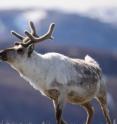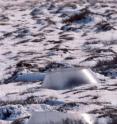Climate change effect on plant communities is buffered by large herbivores, new research suggests
Can existing ecological communities persist intact as temperatures rise? This is a question of increasing relevance in the field of climate change and is the focus of a new study to be published in the journal Proceedings of the Royal Society of London on 20 February. The study suggests that the answer to this question may have as much to do with the biological interactions that shape communities as with the effects of climate change itself. The study's insights are based on a novel approach by Eric Post, a Penn State University professor of biology, who simulated climate change and integrated the effects of large, plant-eating mammals in a 10-year arctic field experiment. The results of the research suggest that plant communities in the Arctic are more likely to resist destabilization by climate change if populations of caribou, musk ox, and other large herbivores remain intact. "The study demonstrates that grazing by these large herbivores maintains plant species diversity, while warming reduces it," Post said. "Plant communities with lower diversity display a greater tendency toward instability under warming, a pre-cursor to the loss of such communities."
Post explained that climate-change research in the 1980s and 1990s was focused primarily on how fluctuations in such factors as temperature, precipitation, and nutrient availability directly affected plant communities. "That research was important and enlightening, but what it did not emphasize were the indirect effects of climate change -- how interactions among species may shape the responses of those species to warmer temperatures," Post said. "If the planet continues to warm by 1.5-to-3.0 degrees Celsius over the next century, as the models predict, we need to know not only what the warming will do to plants and animals directly, but also how species' interactions may influence those effects of warming."
Post began the study in a remote, low-Arctic plant community near Kangerlussuaq, Greenland in 2002. To simulate the effects of the 1.5-to-3.0-degrees-Celsius warming that is predicted to occur over the next century, he erected special warming chambers -- cone-shaped hollow structures that create a greenhouse effect. Some areas on which these warming chambers were placed were left open to grazing by caribou and musk ox -- two ecologically important large herbivores in the Arctic -- while separate 800-square-meter areas that also received warming chambers were fenced off to exclude the animals. In this way, Post created two very different environments: one in which plants and herbivores continued to live together as the temperatures climbed within the warming chambers; the other in which the animals were not present and the plants were left ungrazed.
"The study tested a classic ecological hypothesis, but with a new angle," Post said. "Ecologists have argued for decades over whether species-rich plant communities are more stable, and, hence, persistent in the face of environmental disturbance, than species-poor communities. This study added a layer of complexity by asking whether large herbivores contribute to the diversity-stability relationship in a climate-change context."
After 10 years of careful observation of the Kangerlussuaq, Greenland plant communities, Post found that the grazed and ungrazed sections of land did indeed fare quite differently in their responses to warmer temperatures. "This study confirmed that caribou and musk ox act as a buffer against the degradative effects of warming on plant species diversity," Post said. He found that shrubs such as willow and birch became the dominant plants in response to warming where the herbivorous animals were excluded from the ecosystem. "When these shrubs expand in the plant community, they tend to shade their neighbors, and the build-up of leaf litter around the shrubs tends to cool the soil surface, reducing the availability of soil nutrients for other plants," Post said. "As a result, shrubs can quickly out-compete other plants and reduce species diversity in the process. On the other hand, in those areas where caribou and musk ox were able to graze freely, shrub responses to warming were muted, and species diversity within the plant community was maintained."
Post said the take-home message from his study is that, in a warming climate, intact populations of large herbivores may be crucial to the maintenance of plant-community diversity and to the persistence of existing plant communities. "What this experiment suggests is that factors that threaten the persistence of large herbivores may threaten the plant communities they exist in, as well. Conservation of these herbivores in the rapidly changing Arctic will require careful mediation of interacting stressors such as human exploitation, mineral extraction, and the direct effects of climate change," Post said.
Post said that the next step in his research will be to study the contribution of plant diversity to long-term stability of carbon dynamics in the atmosphere and in the soil.
The research was funded by the National Geographic Society's Committee for Research and Exploration, with additional funding from the Office of Polar Programs at the U.S. National Science Foundation.
Source: Penn State
Other sources
- Climate change effect on plant communities is buffered by large herbivores, new research suggestsfrom Science DailyWed, 20 Feb 2013, 14:00:47 UTC
- Climate change a concern, not a priority to coastal leaders, survey findsfrom PhysorgWed, 20 Feb 2013, 13:00:39 UTC
- Climate change effect on plant communities is buffered by large herbivores, new research suggestsfrom PhysorgWed, 20 Feb 2013, 0:30:53 UTC

